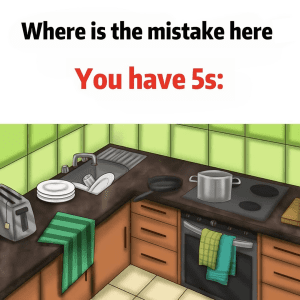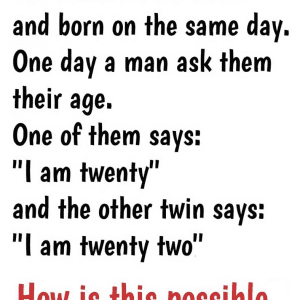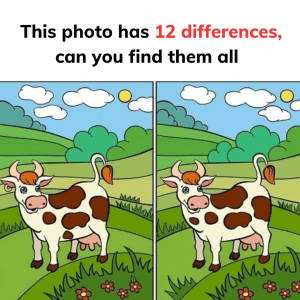Have you ever come across a riddle that stops you in your tracks, forcing you to read it over and over? Here’s a great example of one that’s simple yet incredibly puzzling: “A woman had two sons, born within the same hour, day, and year. But they were not twins. How is this possible?” At first glance, this question seems to defy basic logic, as we naturally think two children born at the same time must be twins. But riddles like this one challenge our usual assumptions and make us look beyond the obvious. So, can you figure it out?
The Appeal of Puzzles: Why We’re Hooked

Riddles have a unique way of drawing us in. A well-crafted riddle is like a mental workout, challenging us to think outside the box and test our logic. The simplicity of the setup often makes the answer seem just out of reach, giving us that “aha!” moment when we finally crack it.
Common Mistakes People Make When Solving the Riddle
Let’s face it: part of what makes this riddle tricky is how it plays with our assumptions. Most people get caught up in the details, and their minds jump to certain conclusions that prevent them from seeing the answer. Let’s go over some of the common mistakes people make.
- Assuming “Twins” Means “Only Two Siblings”
When we hear about two children born at the same time, we immediately think of twins. But here’s the catch: “twins” only describes two children born together in the same birth. We rarely consider other multiple births, like triplets or quadruplets, which can include two children born within the same hour without making them twins. - Overlooking the Possibility of Triplets or Higher Multiples
Most people miss the possibility that these two children could be part of a larger group of siblings born together. Our minds often stop at twins when thinking about simultaneous births, but medical advancements have made triplets, quadruplets, and even quintuplets increasingly common. - Assuming “Born at the Same Time” Means Identical Births
We often link the term “twins” with the concept of identical or fraternal twins, not considering that two children can be born within minutes of each other without fitting this definition. By assuming “born at the same time” means “twins,” we overlook the option of triplets. - Neglecting the Exact Words of the Riddle
A well-designed riddle will provide subtle hints, but only if we pay close attention to each word. This riddle doesn’t say the children are twins—it only states they were born on the same day, hour, and year. The distinction may seem minor, but it’s the key to solving the puzzle.
When solving brain teasers, details are everything. If we misinterpret or make assumptions, even the simplest riddles can become unsolvable.
Solving the Riddle Step-by-Step
Now, let’s break down the riddle in a methodical way. By analyzing each part, we’ll piece together the answer.
Step 1: Analyze the Question
The question states: “A woman had two sons, born within the same hour, day, and year. But they were not twins.” This seems to contradict itself because we usually associate “two sons” born at the same time with the concept of twins. But note, it never says these are the only children born to the woman.
Step 2: Question Your Assumptions
Now, let’s question the assumptions we might be making:
- Are we assuming that there are only two children involved?
- Are we equating “born within the same hour” directly with being twins?
Riddles often use these assumptions to throw us off, so we should explore possibilities that might not be as obvious.
Step 3: Consider the Possibility of Multiples
Here’s the critical insight: just because we’re talking about two sons doesn’t mean they are the only two children born. Let’s explore the idea that these two sons could be part of a set of triplets (or more). If a woman gives birth to triplets, two of those children can be born within minutes of each other, sharing the same hour, day, and year. However, only two would be referenced in the question, meaning they wouldn’t be classified as twins.
Step 4: Apply the Triplet Solution
The solution to the riddle is revealed by considering this possibility: the woman’s sons are two of a set of triplets. In a triplet birth, these two boys could indeed share the same hour, day, and year but would not be twins—they would be triplets. The riddle never asks us about all siblings, so the concept of triplets might not immediately come to mind, but it’s the only logical solution.
Answer:

Once we have the answer, it all makes sense! The two boys are born at the same time, fulfilling the criteria in the question, but since they are part of a triplet set, they’re not classified as twins.
Why Small Details Are Key to Solving Brain Teasers
This riddle demonstrates the importance of paying close attention to details. It’s easy to get caught up in assumptions and miss subtle clues that lead to the correct answer. By carefully reading the wording and analyzing each part, we unlock the solution. This ability to question assumptions and analyze information is a valuable skill, not just for riddles but for critical thinking in general.
Brain teasers like this one can improve our mental flexibility, making us more adept at seeing multiple perspectives and finding creative solutions in everyday situations. Solving puzzles is an excellent way to exercise our cognitive skills, and it reminds us that sometimes the answers we seek are right in front of us—if we’re willing to think outside the box.
Try It for Yourself: Share Your Solution!
Now that we’ve gone through the answer, what was your initial thought when you saw the question? Did you consider the idea of triplets, or were you focused on the concept of twins? It’s always interesting to see how different minds approach the same question, so feel free to share your initial thoughts or any other creative answers you might have considered.
Conclusion: The Joy of Brain Teasers and Logical Thinking
This riddle is a great example of how brain teasers can challenge our logical thinking and encourage us to stretch our minds. Solving puzzles is not only fun but also a valuable exercise for building problem-solving skills and mental agility. If you enjoyed this challenge, consider exploring more riddles and puzzles to keep your brain active and sharp.
Next time you encounter a riddle that seems impossible, remember: sometimes, the answer lies in the details you least expect. Keep an open mind, challenge your assumptions, and embrace the thrill of the “aha!” moment. So, are you ready for more puzzles? Dive in, and see what hidden solutions you might uncover!


